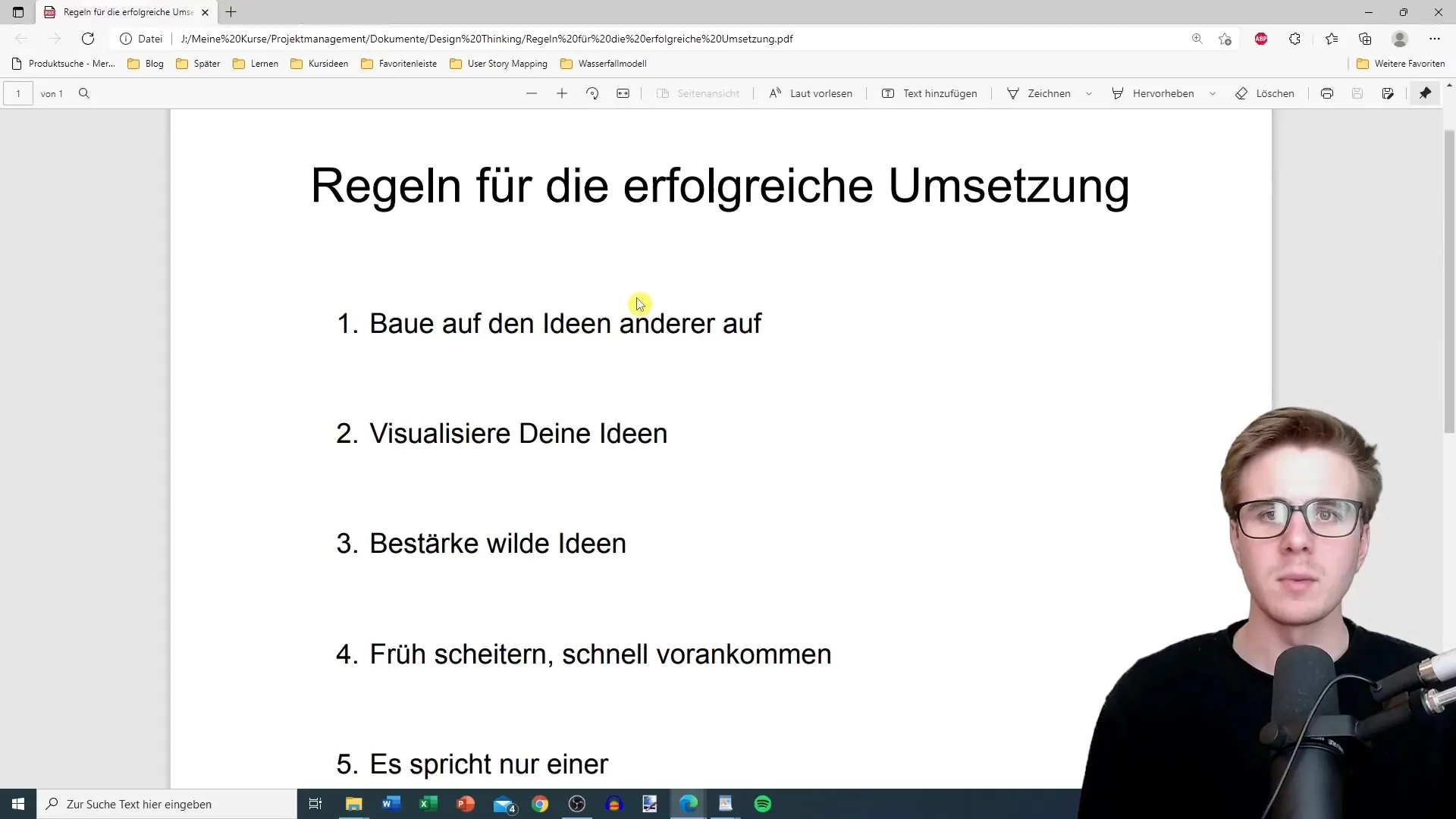You are working in the Design Thinking field and want to ensure that your process runs effectively? In this guide, you will learn some basic rules that will help you optimize idea generation and product development. Design Thinking is a creative approach to problem-solving based on user needs. By following the right rules, you increase your chances of developing innovative and useful solutions.
Key Insights
- Promote the exchange and further development of existing ideas.
- Visualize your concepts to make them tangible.
- Make room for creative and unconventional ideas.
- Accept mistakes as part of the learning process.
- Ensure that only one person speaks in group discussions.
- Focus on the topic during brainstorming sessions.
- Develop numerous ideas even if one is already promising.
- Keep the customer benefit in mind.
- Refrain from critical remarks during idea generation.
Step-by-Step Guide
1. Build on the ideas of others
It's tempting to develop entirely new ideas and create your own masterpieces. However, it can be extremely helpful to orient yourself on existing ideas that have already proven successful. This does not mean that you should directly copy them, but rather analyze how, for example, competitor products are designed, what ingredients are used, or what marketing strategies are applied. These insights can serve as a basis for your own innovations.

2. Visualize your ideas
An idea alone is often not enough. To ensure that it is understood and retained in memory, you should visualize it. This could be done through sketches, mind maps, or diagrams. If you merely discuss ideas in a meeting, they could quickly be forgotten. Through visualization, you not only strengthen understanding but also create a solid foundation for further development.

3. Encourage wild ideas
Who doesn't know those seemingly crazy ideas that are initially laughed at? Often, it is precisely these ideas that are excellent solution approaches. Make room for unconventional ideas because the greatest innovation can arise from the most unexpected suggestions. It is important not to immediately evaluate every idea in the ideation phase. Do not hinder team members from being creative. Let their imagination run wild and work together on further development.
4. Fail early, learn fast
Mistakes are not the end but often the beginning of a new learning process. If you and your team are willing to learn from mistakes and openly discuss them, you can optimize your ideas more quickly. The Design Thinking process is based on the principle of trial and error, so try out and fail fast to search for new solutions. Accepting errors promotes creative thinking and expands the space for innovations.
5. Only one person speaks
In large groups, it can get chaotic if everyone speaks at the same time. To fully grasp ideas and optimize the exchange of thoughts, only one person should speak at a time. This means that everyone else gathers their thoughts while listening. This ensures that the best ideas do not get lost in the noise, and everyone has the opportunity to clearly present their suggestions.
6. Focus and stay on topic
Focusing on the essentials during brainstorming is crucial. Make sure all participants are focused on the current topic to avoid distractions. Ideally, team members gather in one place without digital distractions like phones or other screen devices. Set clear goals and stick to them to achieve the best results possible.
7. Develop many ideas
The first idea is often not the best one. Do not isolate yourself with your first good thought; instead, develop multiple options. The more ideas you generate, the more likely you are to discover innovative approaches or combine existing thoughts. Flexibility and the willingness to think further are crucial here.
8. Always think about the benefit
In Design Thinking, the primary focus is on maximizing customer benefit. Consider how your solution can sustainably solve your target audience's problem. Your goal should be to offer the maximum benefit with minimal effort. If the customer benefit is not met, you have not pursued your task concretely enough, regardless of how much fun you had during development.

9. Hold back with criticism
Criticism can quickly dampen creativity. In the idea generation phase, it is important that all suggestions are accepted without evaluation. Discussions about individual ideas should only take place in a second phase. Let the ideas stand uncommented upon initially to not discourage anyone. A crazy idea may later turn out to be the crucial solution.
Summary - Successful Implementation of Design Thinking
The implementation of the Design Thinking process is a challenging but rewarding experience. By applying these nine rules, you will be able to find more creative and efficient solutions. Remember to build on existing ideas, be creative, and always keep the customer benefit in mind. Mistakes are not a deficiency, but valuable learning opportunities.
Frequently Asked Questions
How important is it to orientate yourself towards existing ideas?It is very important, as successful existing ideas can serve as a basis for developing new concepts.
How can I best visualize my ideas?You can use drawings, mind maps, or diagrams to make your concepts tangible.
Why should I support wild ideas?Wild ideas can lead to unconventional, innovative solutions and stimulate creative processes.
How do I deal with errors in Design Thinking?Accept mistakes quickly, learn from them, and use these insights to further develop your ideas.
What can I do to stay focused?Set clear goals, work in a controlled environment without distractions, and hold meetings offline if possible.


